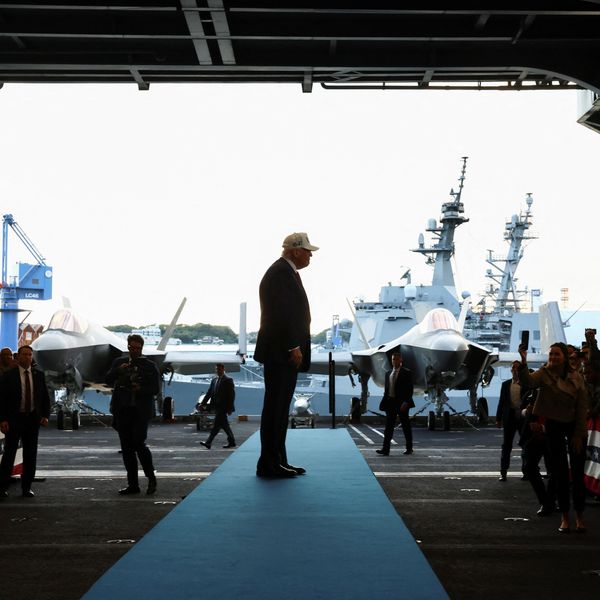No one has ever accused the U.S. military of being a lean, mean, fighting machine. A call to give it $200 billion more split between this year and next won’t do anything to change that reality. But that’s what the new chairman of the Senate Armed Services Committee wants to do. Senator Roger Wicker (R-MS) thinks the money should be pumped into President Trump’s “Iron Dome for America” missile defense shield, as well as “key investments in areas such as shipbuilding, submarines and the Air Force’s next-generation fighter,” Valerie Insinna of Breaking Defense reported.
Such an increase would represent “a magnificent opportunity to make the Defense Department and defense procurement more efficient and modern,” Wicker said. (Did Wicker increase his three kids’ allowances when they made poor choices?) Admiral Mike Mullen, when he was serving as chairman of the Joint Chiefs a decade ago, was closer to the mark when he said the Pentagon’s civilian and military leaders “lost their ability to prioritize” amid the Defense Department’s post-9/11 cash gusher. But Wicker maintains that forcing the Pentagon to buy more commercially, outside of the Defense Department’s crazy procurement process, could generate big benefits.
There’s no doubt that the Big Five defense contractors — Lockheed, Raytheon, Boeing, General Dynamics, and Northrop — have become too cozy inside a bureaucracy designed to serve their interests while keeping interlopers out. “There’s a lot of programs around here that we’ve spent a lot of money on that, when you actually wargame it, don’t have the impact you want them to,” Defense Secretary Pete Hegseth markedly understated February 7. The Defense Department bureaucracy is part of the problem. “There are thousands of additional Pentagon positions, headquarters positions, other positions that have been created over the last 20 years that don’t necessarily translate to battlefield success,” he added. “It’s not just the fraud, waste and abuse stuff — it’s systems, it’s hierarchies, it’s layers that we can review, reduce.”
A big missing part of the defense budget
The pay that U.S. troops earn is part of the U.S. defense budget. But the money we spend taking care of them once they’re out of uniform isn’t. Instead, it’s funded by the Department of Veterans Affairs, an entirely separate Cabinet agency. Yet there’s no true accounting for the cost of the U.S. military unless you calculate just how much we’re spending on our nearly 16 million veterans: while the Pentagon paid troops $236 billion in total compensation last year, the VA spent $365 billion (PDF) on former troops.
“After experiencing very little growth from 1980 to 1999, VA’s budget has more than quadrupled in real terms” — not counting inflation — “since 1999,” the Congressional Budget Office says in a new report (PDF). The two biggest chunks of the VA’s budget are for benefits and medical care. “Each of those programs is approaching the size of DoD’s military personnel budget,” CBO says. The VA is seeking $369 billion this year, 9.8% more than in 2024.
This quadrupling of costs — in real terms — is happening despite the fact that the number of U.S. veterans has been shrinking. And not only that: “Furthermore, the number of combat veterans has been decreasing as a share of veterans who receive disability compensation — even though the United States was engaged in operations in Iraq and Afghanistan for more than 10 years,” the agency added. “Because of policy changes, veterans who served after 9/11 (known as Gulf War II veterans) are more likely to get benefits, whether they served in combat or not.”
Veterans deserve every penny they’ve got coming to them. And taxpayers deserve to have each one counted as part of the defense budget. The VA’s skyrocketing spending is just as much a part of the cost of waging war as the boots, bullets, and battleships bought by the Pentagon.
Sudden paint job for the Pentagon’s new boss
The Bunker believes troops and veterans deserve their pay and benefits — and we feel the same about the dwellings that house many active-duty service personnel. In fact, René Kladzyk here at the Project On Government Oversight has reported on the persistent problems with the Pentagon’s push to privatize military housing, including the widespread mold and rigged oversight that shortchange those in uniform and their families.
So it caught our attention when a pair of House Appropriations Committee Democrats questioned the $49,900 “emergency” paint job for Defense Secretary Pete Hegseth’s government-owned home in a February 7 letter to the new defense chief. “It was not until February 5, 2025,” Reps. Debbie Wasserman Schultz of Florida and Rosa DeLauro of Connecticut wrote, “that the committee learned that you would be the occupant of this family housing unit.”
“Family housing unit” and “$49,900…for an ‘emergency’ paint job” are rarely paired together when it comes to federal military barracks housing. “How does that use of funds comply with the Administration’s stated goal of government efficiency?” the lawmakers asked. All told, they asked Hegseth to explain the $137,297 the Army spent sprucing up his home before he moved in.
Defense secretaries, unlike the uniformed members of the Joint Chiefs of Staff and other top officers, usually live in their own homes. The lawmakers asked why Hegseth needs government housing at an unidentified location near the Pentagon, and how much rent he is paying.
The flappable defense chief exploded after Jennifer Griffin, Fox News’ Pentagon reporter, tweeted about the letter. Surprisingly, he lumped the straight-arrow Griffin among “Trump haters” for simply posting the lawmakers’ newsworthy inquiry. “Any/all house repairs were going to happen no matter who was moving in — and were all initiated by DoD,” Hegseth harrumphed.
The Bunker has no doubt some faceless Pentagon bureaucrat ordered the spiffing up. That’s the autopilot nature of defense spending that has bedeviled the U.S. military for decades. But if Hegseth truly believes the work was to be done “no matter who was moving in,” the man has no business trying to run the Department of Defense.
Here’s what has caught The Bunker’s eye recently
Crewless aircraft are a double-edged sword when it comes to nuclear strategy, increasing deterrence but also the chances of escalation, Lawrence J. Korb, a former top defense official, and political scientist Stephen Cimbala, wrote February 7 in The National Interest.
Russia is investigating a plot to send exploding goggles to its front-line drone operators, Howard Altman reported February 7 at The War Zone.
→ “You have been disconnected…”
The fiber-optic cables that knit together the world are increasingly being shredded by ships most likely belonging to China and Russia, Gabriella Gricius wrote February 5 for the Jamestown Foundation.
Thanks for connecting with The Bunker this week. Consider forwarding this on to your chums so they can subscribe here.
- Getting the defense budget right: A (real) grand total, over $1.4 trillion ›
- Congress is crying wolf again on the Pentagon budget ›
- 'Humiliated': Pentagon fails 7th audit in a row ›
- Hegseth orders 8% cut to Pentagon budget. Not so fast. | Responsible Statecraft ›
















